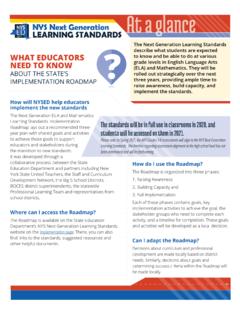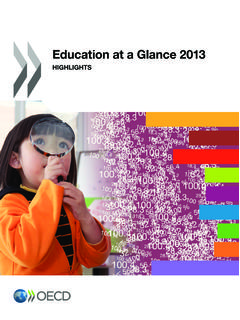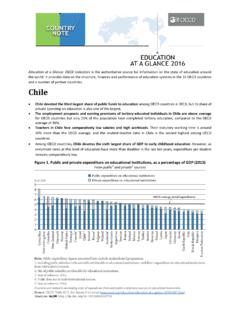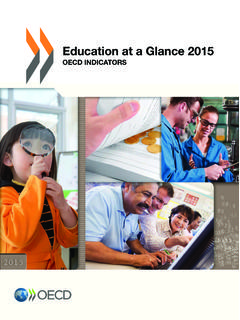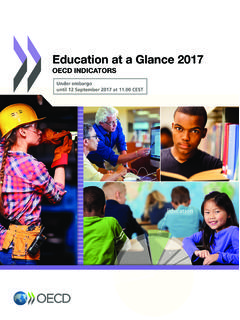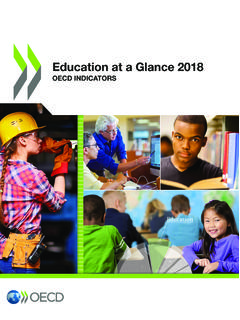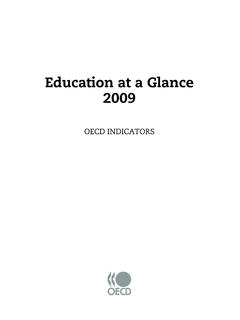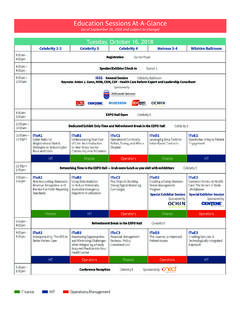Transcription of Education at a Glance 2011 - OECD.org
1 Education at a Glance 2011. OECD indicators This work is published on the responsibility of the Secretary-General of the OECD. The opinions expressed and arguments employed herein do not necessarily reflect the official views of the Organisation or of the governments of its member countries. Please cite this publication as: OECD (2011), Education at a Glance 2011: OECD Indicators, OECD Publishing. ISBN 978-92-64-11420-3 (print). ISBN 978-92-64-11705-1 (PDF). Photo credits: Stocklib Image Bank Cathy Yeulet Feng Yu Getty Images blue jean images Corrigenda to OECD publications may be found on line at: OECD 2011. You can copy, download or print OECD content for your own use, and you can include excerpts from OECD publications, databases and multimedia products in your own documents, presentations, blogs, websites and teaching materials, provided that suitable acknowledgment of OECD as source and copyright owner is given.
2 All requests for public or commercial use and translation rights should be submitted to Requests for permission to photocopy portions of this material for public or commercial use shall be addressed directly to the Copyright Clearance Center (CCC) at or the Centre fran ais d'exploitation du droit de copie (CFC) at Foreword Governments are paying increasing attention to international comparisons as they search for effective policies that enhance individuals' social and economic prospects, provide incentives for greater efficiency in schooling, and help to mobilise resources to meet rising demands. As part of its response, the OECD Directorate for Education devotes a major effort to the development and analysis of the quantitative, internationally comparable indicators that it publishes annually in Education at a Glance .
3 These indicators enable educational policy makers and practitioners alike to see their Education systems in the light of other countries' performances and, together with OECD's country policy reviews, are designed to support and review the efforts that governments are making towards policy reform. Education at a Glance addresses the needs of a range of users, from governments seeking to learn policy lessons to academics requiring data for further analysis to the general public wanting to monitor how its nation's schools are progressing in producing world-class students. The publication examines the quality of learning outcomes, the policy levers and contextual factors that shape these outcomes, and the broader private and social returns that accrue to investments in Education .
4 Education at a Glance is the product of a long-standing, collaborative effort between OECD governments, the experts and institutions working within the framework of the OECD's Indicators of Education Systems (INES). programme and the OECD Secretariat. The publication was prepared by the Indicators and Analysis Division of the OECD Directorate for Education with input from the Centre for Educational Research and Innovation, under the responsibility of Andreas Schleicher, in co-operation with Etienne Albiser, Eric Charbonnier, Pedro Lenin Garcia de L on, Bo Hansson, Corinne Heckmann, Estelle Herbaut, Karinne Logez, Koji Miyamoto and Jean Yip. Administrative support was provided by Sandrine Meireles and Rebecca Tessier, editing of the report was undertaken by Marilyn Achiron and additional advice as well as analytical and editorial support were provided by Marika Boiron, Ji Eun Chung, Ana s Dubreucq-Le Bouffant, Maciej Jakubowski, Manal Quota, Giannina Rech and Elisabeth Villoutreix.
5 Production of the report was co-ordinated by Corinne Heckmann and Elisabeth Villoutreix. The development of the publication was steered by member countries through the INES Working Party and facilitated by the INES Networks. The members of the various bodies as well as the individual experts who have contributed to this publication and to OECD INES more generally are listed at the end of the book. While much progress has been accomplished in recent years, member countries and the OECD continue to strive to strengthen the link between policy needs and the best available internationally comparable data. In doing so, various challenges and trade-offs are faced.
6 First, the indicators need to respond to educational issues that are high on national policy agendas, and where the international comparative perspective can offer important added value to what can be accomplished through national analysis and evaluation. Second, while the indicators need to be as comparable as possible, they also need to be as country-specific as is necessary to allow for historical, systemic and cultural differences between countries. Third, the indicators need to be presented in as straightforward a manner as possible, while remaining sufficiently complex to reflect multi-faceted educational realities. Fourth, there is a general desire to keep the indicator set as small as possible, but it needs to be large enough to be useful to policy makers across countries that face different educational challenges.
7 The OECD will continue to address these challenges vigorously and to pursue not just the development of indicators in areas where it is feasible and promising to develop data, but also to advance in areas where a considerable investment still needs to be made in conceptual work. The further development of the OECD. Programme for International Student Assessment (PISA) and its extension through the OECD Programme for the International Assessment of Adult Competencies (PIAAC), as well as OECD's Teaching and Learning International Survey (TALIS) are major efforts to this end. Education at a Glance OECD 2011 3. Table of Contents Number of the indicator in the 2010 edition Editorial.
8 13. 21. Reader's 25. Chapter A The output of Educational institutions and the impact of 29. Indicator A1 To what level have adults studied?.. 30 A1. Table Educational attainment: Adult population (2009)..38. Table Population with at least upper secondary Education (2009)..39. Table Population with tertiary Education (2009)..40. Table Trends in educational attainment: 25-64 year-olds (1997-2009)..41. Indicator A2 How many students finish secondary Education ?..44 A2. Table Upper secondary graduation rates (2009)..54. Table Trends in graduation rates (first-time) at upper secondary level (1995-2009)..55. Table Post-secondary non-tertiary graduation rates (2009).
9 56. Table Successful completion of upper secondary programmes, by gender and programme Indicator A3 How many students finish tertiary Education ?.. 60 A3. Table Graduation rates at tertiary level (2009)..68. Table Trends in tertiary graduation rates (1995-2009)..69. Table Graduation rate at different tertiary levels, impact of international/foreign students (2009)..70. Table Structure of tertiary Education : Main programme blocks (2009)..71. Indicator A4 To which fields of Education are students attracted?.. 72. Table Distribution of upper secondary vocational graduates, by field of Education and gender (2009)..82. Table Distribution of new entrants into tertiary programmes, by field of Education (2009).
10 83. Table Percentage of tertiary qualifications awarded to women in tertiary-type A. and advanced research programmes, by field of Education (2000, 2009)..84. Table Distribution of enrolment in tertiary programmes, by field of Education (2009)..85. Table Distribution of international and foreign students enrolled in tertiary programmes, by field of Education (2009)..86. Table Science-related graduates among 25-34 year-olds in employment, by gender (2009)..87. Education at a Glance OECD 2011 5. Table of Contents Number of the indicator in the 2010 edition Indicator A5 Does student background affect student performance?.. 88. Table Socio-economic background and reading Table Percentage of students by immigrant status and their reading Table Percentage of resilient students and disadvantaged low achievers among all students, by Indicator A6 Are students who enjoy reading better readers?










